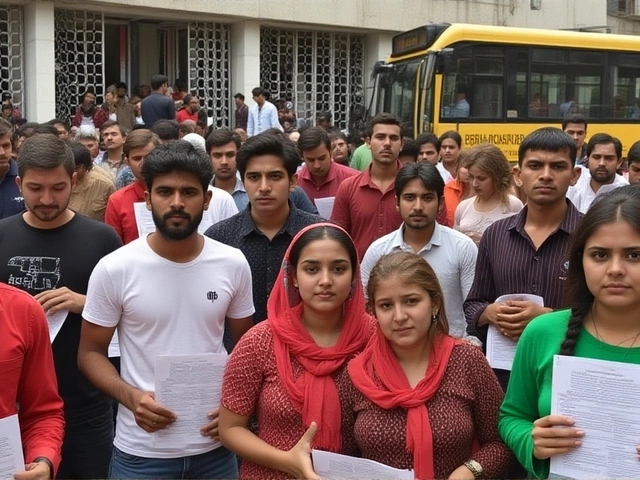When India Meteorological Department (IMD) released a severe weather alert Uttar Pradesh on October 6, 2025, residents of sixteen districts—including Noida and Ghaziabad—were urged to brace for heavy rain, strong gusts and hail the size of a marble. The warning, signed off by Dr. Sunil Kumar, Director General of the IMD, carries the highest severity level, meaning flash‑flooding, road closures and power outages are all on the table.
What the Alerts Entail
The alert lists a 90‑percent probability of 70‑120 mm of rain across the western districts and up to 150 mm in the central belt, with hail expected between 14:00 IST and 19:00 IST. Wind speeds could peak at 45 km/h, enough to topple poorly anchored structures. In Noida, the forecast calls for 115 mm of rain and hailstones up to 1 cm in diameter—large enough to dent car windshields.
Authorities have issued a "red" warning, the most urgent tier in IMD’s tri‑level system. Residents are told to keep sandbags handy, avoid low‑lying areas, and stay off the roads unless absolutely necessary.
Meteorological Factors Behind the Storm
The thunderstorm swarm is being driven by a classic western disturbance that slipped south from the Himalayas earlier Friday. This cold air mass clashed with moist, warm winds from the Bay of Bengal, creating a steep temperature gradient over the Indo‑Gangetic plain.
Adding to the mix, a weak low‑pressure system hovering over eastern Rajasthan amplified the uplift, while rising humidity levels—now hovering around 85 % in Delhi‑NCR—fed the convective cells that spawn hail. The IMD’s super‑computer modeled a rapid intensification, hence the sudden jump from a “yellow” to a “red” alert.
Impact on Daily Life and Infrastructure
- Transportation: Major highways like NH‑19 are expected to see water‑logged stretches near Meerut and Agra, prompting the Uttar Pradesh State Disaster Management Authority (UPSDMA) to pre‑position rescue teams.
- Power: Preliminary estimates suggest up to 350 MW of electricity could be knocked out in the affected zones if tree limbs snag high‑voltage lines.
- Agriculture: The timing is critical—crop‑bearing fields of wheat in the Terai region risk damage, potentially shaving off 7‑10 % of the expected yield.
- Public health: Stagnant water will likely breed mosquitoes, raising concerns about dengue and malaria spikes in the weeks that follow.
Local shopkeepers in Gorakhpur reported that sales of trucks and sandbags have already spiked by 30 % compared to a typical Saturday.

Responses from Authorities and Communities
Chief Minister Yogi Adityanath convened an emergency meeting with the UPSDMA and the city mayors of Lucknow, Varanasi and the three western districts. He announced a ₹500 million relief package earmarked for immediate rescue operations and temporary shelters.
"We cannot afford a repeat of the 2019 floods," the CM said, urging municipal bodies to activate flood‑control gates along the Ganga and its tributaries.
On the ground, volunteers from NGOs such as Goonj are distributing dry blankets and bottled water in the low‑lying villages of Barabanki. Residents in Aligarh have already sandbagged their homes, a practice that proved effective during the monsoon of 2022.
Historical Context and Climate Outlook
Uttar Pradesh has a fraught history with extreme rainfall events. The 2019 floods, precipitated by a similar western disturbance, left over 200 000 people displaced and caused economic losses estimated at ₹12 billion. Climate scientists warn that such high‑intensity downpours are becoming more frequent as the Indian subcontinent warms faster than the global average.
Dr. Ananya Singh, a climatologist at the Indian Institute of Technology (IIT) Kanpur, noted, "The atmospheric moisture holding capacity increases by about 7 % for every 1 °C rise. That translates to heavier rain events even if the overall monsoon duration stays the same."
According to the latest IPCC assessment, South Asia could see a 20‑30 % rise in extreme precipitation days by 2050, making the current alert a harbinger of what's to come.

Looking Ahead: Next Steps
The IMD will issue hourly updates through its official portal and the SMS‑based Weather Alert System. Citizens are encouraged to download the "IMD Weather App" for real‑time notifications.
Meanwhile, the UPSDMA plans to deploy additional aerial drones to assess flood‑plains after the storm passes, aiming to speed up relief distribution.
In the long term, the state government has pledged to invest ₹10 billion in upgrading drainage infrastructure across the most vulnerable districts, a move that aligns with the national "Smart Cities" initiative.
Key Facts
- Alert issued: October 6, 2025, 07:00 IST
- Severity: Red (highest level)
- Rainfall forecast: 70‑150 mm across 16 districts
- Hail size: up to 1 cm, expected between 14:00‑19:00 IST
- Wind gusts: up to 45 km/h
Frequently Asked Questions
How will the hail affect daily commuters?
Hail can quickly make roads slick and damage vehicle windshields. The UPSDMA advises commuters to avoid non‑essential travel, especially on highways near Noida, Ghaziabad and Meerut, where hail intensity is projected to be highest.
What measures are being taken to protect vulnerable farmers?
The state agriculture department has pre‑positioned 2,000 kg of sandbags and mobile pumps in the most at‑risk districts. Farmers are being urged to secure stored grain in waterproof containers and to delay planting until after the storm passes.
Who can residents contact for emergency assistance?
The UPSDMA’s 24‑hour helpline (1800‑555‑555) is operational throughout the alert period. Local police stations and designated disaster response centers in Lucknow and Varanasi are also equipped to dispatch rescue teams.
What caused this severe weather event?
A western disturbance moving south from the Himalayas collided with a moist air mass from the Bay of Bengal, creating a sharp temperature gradient. This, combined with high humidity, triggered intense convection and hail formation across the Indo‑Gangetic plain.
Will the IMD issue further alerts after October 6?
The IMD says it will monitor the system closely and issue updates every three hours. If rainfall intensity eases, a downgrade to a "yellow" warning could follow, but residents should stay tuned until the system fully dissipates.





